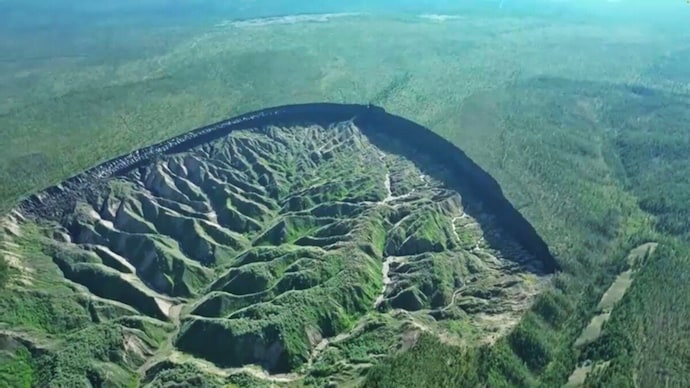
World's biggest permafrost crater has a warning for Earth
The Batagaika crater, the world's largest permafrost crater, is expanding at an alarming rate due to the thawing of the permafrost.

In Short
- The crater is located in the Sakha Republic
- It is a one-kilometre-long gash that reaches depths of up to 100 metres
- Over the years, the crater has continued to expand
By India Today Science Desk: In the remote reaches of Russia's Far East, a gaping hole in the Earth's surface continues to grow, serving as a stark reminder of the impacts of climate change.
The Batagaika crater, the world's largest permafrost crater, is expanding at an alarming rate due to the thawing of the permafrost, a phenomenon catalysed by global warming.
Permafrost is a type of ground or soil that remains frozen at or below the freezing point (0 degrees Celsius or 32 degrees Fahrenheit) for two or more consecutive years. It is found in regions where the temperature remains consistently cold throughout the year, typically in high-latitude regions near the poles, such as in the Arctic and subarctic regions.
Also Read | 10 days after launch: Here's where Chandrayaan-3 is right now
The crater, located in the Sakha Republic, is a one-kilometre-long gash that reaches depths of up to 100 metres. It began forming in the 1960s after deforestation led to the melting of the underground permafrost, causing the land to sink.
Over the years, the crater has continued to expand, earning it the local nickname 'the cave-in'.
Local resident and crater explorer Erel Struchkov, who has witnessed the crater's growth over the years, told Reuters, "It developed in the 1970s, first as a ravine. Then by thawing in the heat of sunny days, it started to expand."
Also Read | Elementary, my dear Watson: Sherloc finds building blocks of life on Mars
Russia is warming at least 2.5 times faster than the rest of the world, leading to the melting of the long-frozen tundra that covers about 65% of the country's landmass. This rapid warming is releasing greenhouse gases stored in the thawed soil, contributing to the acceleration of global warming.
Nikita Tananayev, lead researcher at the Melnikov Permafrost Institute in Yakutsk, warns that the expansion of the Batagaika crater is a sign of danger. "In future, with increasing temperatures and with higher anthropogenic pressure, we will see more and more of those mega-slumps forming, until all the permafrost is gone," Tananayev said.
The thawing permafrost has already had devastating effects on northern and northeastern Russia, causing infrastructure damage such as buckling roadways, splitting houses, and disrupting pipelines. The problem is further exacerbated by increasingly intense wildfires.
Locals have taken note of the crater's rapid growth. Struchkov noted that the edge of the crater was about 20-30 metres away from a path two years ago, but now it is much closer.
Also Read | Isro ready to launch PSLV-C56 mission with seven foreign satellites
Scientists are unsure of the exact rate at which the Batagaika crater is expanding. However, they warn that the soil beneath the slump contains an enormous quantity of organic carbon that will be released into the atmosphere as the permafrost thaws, further fuelling the planet's warming.
"With an increasing air temperature we can expect (the crater) will be expanding at a higher rate," Tananayev said. "This will lead to more and more climate warming in the following years."
As the Batagaika crater continues to grow, experts warn the urgent need for action to mitigate the impacts of climate change.
Also Read | Gaganyaan mission moves to next phase, Navy conducts recovery trials


